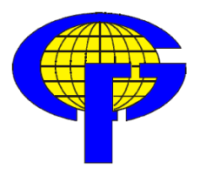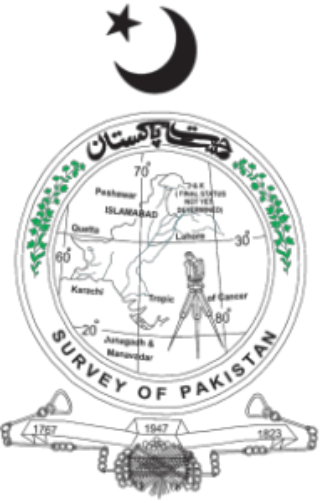
Topography is the study of the forms and features of land surfaces. The topography of an area may refer to the land forms and features themselves, or a description or depiction in maps.

Geomatics is defined in the ISO/TC 211 series of standards as the "discipline concerned with the collection, distribution, storage, analysis, processing, presentation of geographic data or geographic information". Under another definition, it consists of products, services and tools involved in the collection, integration and management of geographic (geospatial) data. It is also known as geomatic(s) engineering. Surveying engineering was the widely used name for geomatic(s) engineering in the past.

Geoinformatics is a technical science primarily within the domain of Computer Science. It focuses on the programming of applications, spatial data structures, and the analysis of objects and space-time phenomena related to the surface and underneath of Earth and other celestial bodies. The field develops software and web services to model and analyse spatial data, serving the needs of geosciences and related scientific and engineering disciplines. The term is often used interchangeably with Geomatics, although the two have distinct focuses; Geomatics emphasizes acquiring spatial knowledge and leveraging information systems, not their development.
The American Congress on Surveying and Mapping (ACSM) was an American professional association representing the interests of those engaged in measuring and communicating geospatial data.
The Indian Institute of Remote Sensing is an institute for research, higher education and training in the field of remote sensing, geoinformatics and GPS technology for natural resources, environmental and disaster management under the Indian Department of Space, which was established in the year 1966. It is located in the city of Dehradun, Uttarakhand.

The International Cartographic Association (ICA), is an organization formed of national member organizations, to provide a forum for issues and techniques in cartography and geographic information science (GIScience). ICA was founded on June 9, 1959, in Bern, Switzerland. The first General Assembly was held in Paris in 1961. The mission of the International Cartographic Association is to promote the disciplines and professions of cartography and GIScience in an international context. To achieve these aims, the ICA works with national and international governmental and commercial bodies, and with other international scientific societies.
The American Society for Photogrammetry and Remote Sensing (ASPRS) is an American learned society devoted to photogrammetry and remote sensing. It is the United States' member organization of the International Society for Photogrammetry and Remote Sensing. Founded in 1934 as American Society of Photogrammetry and renamed in 1985, the ASPRS is a scientific association serving over 7,000 professional members around the world. As a professional body with oversight of specialists in the arts of imagery exploitation and photographic cartography. Its official journal is Photogrammetric Engineering & Remote Sensing (PE&RS), known as Photogrammetric Engineering between 1937 and 1975.

The Faculty of Geodesy at the University of Zagreb is the only Croatian institution providing high education in Geomatics engineering and the largest faculty in this domain in southeastern Europe.

The Chartered Institution of Civil Engineering Surveyors or CICES is a professional association in the field of civil engineering surveying, headquartered in the United Kingdom. CICES members consist mainly of commercial managers, quantity surveyors, and geospatial engineers working and studying within civil engineering surveying. The institution began in 1969 as the Association of Surveyors in Civil Engineering, became a registered educational charity in 1992, and received a royal charter in 2009. The institution advocates for engineering projects and education.

The UNSW School of Surveying and Geospatial Engineering (SAGE), part of the UNSW Faculty of Engineering, was founded in 1970 and disestablished in 2013.

Survey of Pakistan is the sole national mapping and land surveying government agency of Pakistan. Its head of department is titles as "Surveyor General of Pakistan".
The Faculty of Geodesy and Land Management is one of the sixteen faculties of University of Warmia and Mazury in Olsztyn and prepares students to work in the following fields: digital photogrammetry and Internet photogrammetry, close range photogrammetry, engineering geodesy, satellite geodesy, higher geodesy, geomatics and spatial information systems, land management, numerical cartography, cadastral survey and common appraisal, mathematics and mathematical statistics, spatial and archeological reconstruction, positioning and navigation systems, remote sensing and photointerpretation, theory of deterministic chaos in dynamic analyses, theory of environment and real estate evaluation. Students of land management are prepared to work in local governments in the fields of real estate management and turnover, spatial planning, property counselling and expertise. Research on application of global satellite navigation systems, improving methods of acquiring, gathering and processing geodetic and satellite data and their use in special information systems as well as optimizing methods of space management are only a few examples of scientific fields of interest of the faculty employees.
The Indian Institute of Surveying & Mapping (IISM), formerly known as Survey Training Institute, is an institution of Survey Education, learning and training. It is situated at the Survey of India campus in Uppal, Hyderabad.
The Urban and Regional Information Systems Association (URISA) is a non-profit association of professionals using geographic information systems (GIS) and other information technologies to solve challenges at all levels of government. URISA promotes the effective and ethical use of spatial information and technology for the understanding and management of urban and regional systems.

Q150 was the sesquicentenary of the Separation of Queensland from New South Wales in 1859. Separation established the Colony of Queensland which became the State of Queensland in 1901 as part of the Federation of Australia. Q150 was celebrated in 2009.

The Association of British Columbia Land Surveyors (ABCLS) is a self-governing, non-profit, non-governmental organization which sets educational requirements, examines for admission, and regulates professional land surveyors within British Columbia, Canada. The ABCLS is responsible for developing bylaws and guidelines for the conduct of its members, establishing and administering entry requirements for the profession, and liaising with governmental bodies and other associations to improve the quality of the profession's service to the public.

Kaduna Polytechnic is one of the earliest polytechnics in Nigeria, located at Tudun Wada area of Kaduna South local government of Kaduna state, North-Western Nigeria. It was established in 1956 as Kaduna Technical Institute after the British Government accepted the upgrading of Yaba Higher College to a technical institute and also proposed the establishment of technical institutes in Kaduna and Enugu through the recommendation of the Higher Education Commission. The polytechnic offers National Diploma and Higher National Diploma courses at the undergraduate level. In 2019/2020 academic session the institute will start awarding National Diploma in Railway Engineering Technology as approved by NBTE on 30 January 2020. The board of Governors of Kaduna Polytechnic was set up in 1991, with representative of eleven state governments, universities, rectors. The board is responsible for the supervision and control of the school. They are called the Governing Council.
Geographic data and information is defined in the ISO/TC 211 series of standards as data and information having an implicit or explicit association with a location relative to Earth. It is also called geospatial data and information, georeferenced data and information, as well as geodata and geoinformation.
Sisi Zlatanova is a Bulgarian/Dutch researcher in geospatial data, geographic information systems, and 3D modeling. She works as a professor in the faculty of the Built Environment, at the University of New South Wales (UNSW), and is president of Technical Commission IV (Spatial Information Science) of the International Society for Photogrammetry and Remote Sensing.
The Journal of Spatial Science is an academic journal about spatial sciences published by Taylor & Francis on behalf of the Mapping Sciences Institute (Australia) and the Surveying and Spatial Sciences Institute. It covers cartography, geodesy, geographic information science, hydrography, digital image analysis and photogrammetry, remote sensing, surveying and related areas. Its editor-in-chief is Graeme Wright; its 2018 impact factor is 1.711.
















